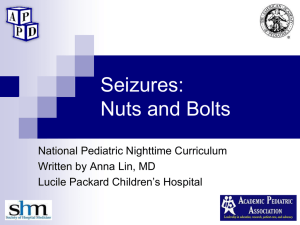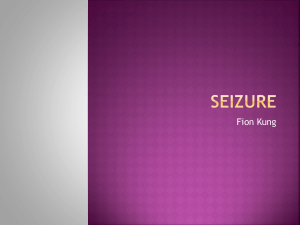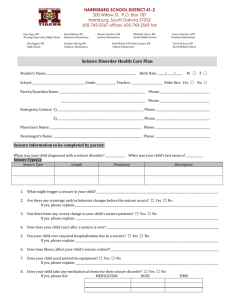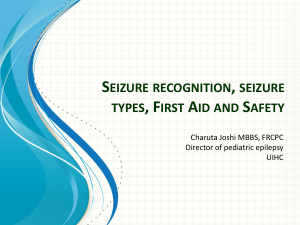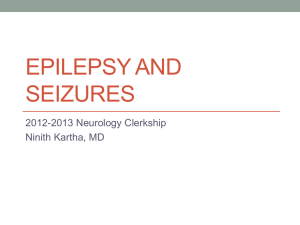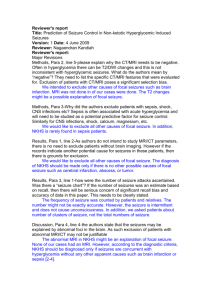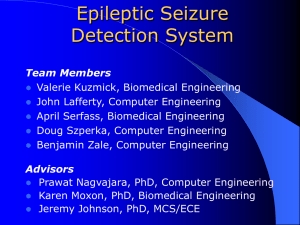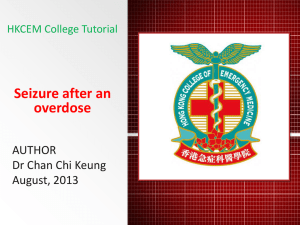Review of Seizures and Nursing Care
advertisement
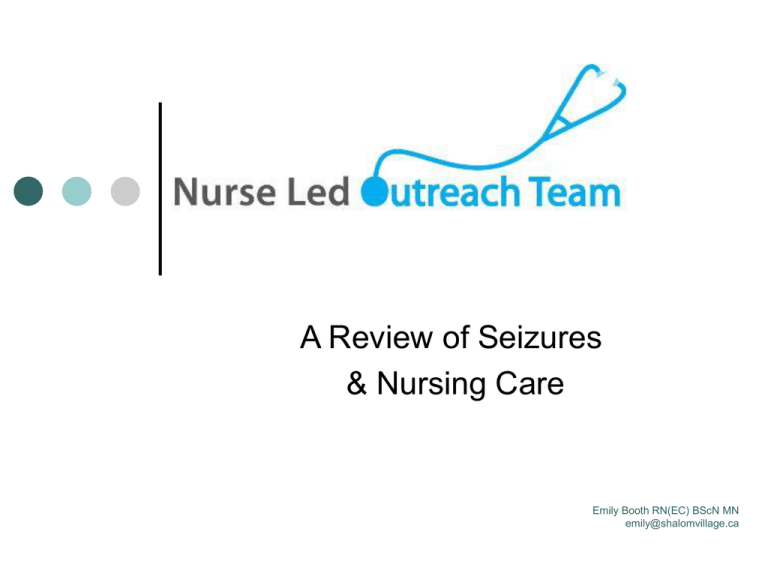
A Review of Seizures & Nursing Care Emily Booth RN(EC) BScN MN emily@shalomvillage.ca Goals: To understand the signs and symptoms of a seizure To understand the nursing care that can be offered pre, during and post seizure activity To understand how to use the suctioning machine What is a Seizure? A sudden, abnormal, excessive electrical discharge from the brain that can change motor and/or autonomic function, consciousness or sensation Epileptic vs Non-Epileptic Epileptic An abnormal excessive amount of neural activity in the brain that originates in the central nervous system Non-Epileptic A response to stimulus that does not originate in the central nervous system What are some causes of non-epileptic seizures? Alcohol withdrawal Fever Hypoxia Drug Intoxication Poisoning Cardiopulmonary Blood Loss Metabolic Tumours Head Injury Hyperthermia …and many more 2 Basic Types of Seizures Partial Start in a specific part of the brain Simple – no loss of consciousness Complex – loss of consciousness Generalized Affect the whole brain (Absence/petit mal and tonic-clonic/grand mal) If a partial becomes a generalized, called a secondary generalized seizure Signs and Symptoms of Impending Seizure Activity The person reports unusual symptoms including: Smelling burnt toast Feeling of spiders crawling on arms Other odd odours, tastes or sensations Auras Terminology Ictus The actual seizure activity Postictal phase Post seizure Partial Seizure - Simple Confined to 1 brain lobe Person is fully aware but unable to control what is happening May have sudden intense feelings of fear, bliss or déjà vu May have aura, tingling/numbing sensation, see flashing lights Ictus phase usually short, which can make it difficult to identify true seizure activity Symptoms correspond to brain lobe involved… Frontal: movement of extremity or change in speech Temporal: memory, sound, smell, emotions* Parietal: tingling or feeling of warmth down one side of body Occipital: see flashing lights, fireballs, bright colours shooting across half visual field Nursing Management of a Partial Seizure Symptoms can be frightening to the conscious person Offer reassurance this will pass Assess immediate environment Remember – a partial can be a warning sign for a stronger seizure Partial Seizures - Complex Affects an entire hemisphere; does not spread Person can not respond to commands and will not remember event May appear to be fully awake but with a blank stare Automatisms – involuntary automatic behaviours such as chewing, lip smacking, hallucinations, odd behaviour (undressing or laughing uncontrollably) Postictal phase may be minimal or nonexistent Without warning, mall fall to the ground Nursing Management Same as partial seizures If person falls to the ground, assess for injury, limb displacement Behaviour may change if person thinks he is being restrained – do not restrain! Use a calm and reassuring voice If the person gets up and starts walking away, be prepared to follow Generalized Seizures – Non Convulsive Also called Absence or Petit Mal May stop speak mid sentence, blank stare Repeated lip smacking/eye blinking Sudden brief lapse of consciousness Will not remember event Can be frequent but very short duration Can normally continue with activities they were doing before seizure Generalized – Atypical Absence/Petit Mal Longer than generalized non convulsive Up to 45 minutes Longer recovery time Loss of awareness not always complete Generalized – Myoclonic Seizures Sudden brief jerking of muscle group(s) lasting a few seconds Affected areas can range from pinky finger to entire torso Person may report soreness or cramping in area that was affected Can affect bowel/bladder control May lead to a tonic clonic seizure Generalized – Atonic Seizures Occurs as result of sudden loss of tone in postural muscles Will drop to ground if standing/slump if in chair Consciousness will be lost for a split second Common injuries include ankles, knees, chin (site of impact) Generalized – Convulsive Seziures Tonic-Clonic/Grand Mal Muscle spasm in which arms and legs flex Alternates between contraction and relaxation Can strike without warning Initial tonic phase – falls, brief flexion of back followed by staring Arms may be up in air, signalling tonic phase is about to start Generalized – Convulsive Seizures Continued May scream or moan as air is pushed from lungs in a tight spasm Breathing could be impaired during this time/become cyanotic May lose bladder/bowel control Pupils may become dilated Muscular contractions start at 8 spasms per second and intensify Can appear very violent Generalized – Convulsive Transition from Tonic to Clonic As tonic evolves, periods of muscle relaxation will occur/lengthen until end of seizure Postictal phase – will be very still with flaccid muscles Excessive salvation can obstruct airway Minutes to hours to regain consciousness Exhaustion – may sleep for hours Will not remember the episode May have head ache, muscle aches, injuries Nursing Management of a Generalized Seizure Communicate throughout the episode, give reassurance it will be stopped and he won’t be left along Protect ehad from banging on floor while convulsive movements occur Loosen tight clothing Try to turn into recovery position Do not force anything in mouth Check frequently after all seziure activity ends Status epileptics – lasts longer than 30 minutes – an emergency! Suctioning Equipment Suction machine Suction tubing and oral sucker/younker Sterile water Personal protective equipment as needed Suctioning Procedure Attach tubing and younker, ensure good fit; turn on machine Gently insert younker into mouth Move to all parts of mouth as necessary Clean suction tubing/younker by suctioning sterile water Oral younker may be used on same person for 24hrs Collection container good for 24hrs Document – Amount, appearance, any trauma Suctioning Reminders Never use the younker to ‘pry’ open the mouth/teeth Never use fingers to pry open mouth/teeth If person starts biting, do not use the younker as a bit block Talk to the person during the entire procedure


